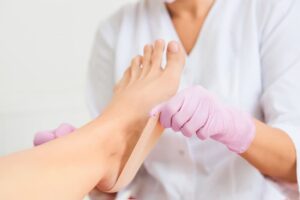If you worry about the welfare of your elderly loved one in a nursing home, you’re not alone. Many families trust these facilities to provide care and support for their cherished relatives.
However, when warning signs like bed sores appear, you need to question the quality of your loved one’s care. Bed sores often point toward neglect or abuse. Our New Port Richey nursing home abuse lawyers are ready to protect your loved ones with experienced legal support.
What Are Bed Sores?

Bed sores are injuries to the skin and underlying soft tissues resulting from prolonged pressure. They most commonly develop on skin that covers bony areas, such as the heels, ankles, hips, and tailbone. People most at risk for bed sores include those with conditions that limit the ability to change positions and those who spend most of their time in beds or chairs.
Bed sores develop when pressure restricts blood supply to the skin for extended periods, causing the skin to die. The depth, severity, and location of the sores can vary. Without proper treatment, these sores can deepen, extending into the muscle and bone and leading to severe and fatal infections.
Factors like immobility, poor nutrition, and moisture increase the risk. Bed sores can lead to more severe health issues and complicate existing conditions. Regularly repositioning patients and maintaining good skin care can prevent almost all bed sores.
The Different Stages of Bed Sores
As bed sores develop, they progress through distinct stages, each characterized by its depth, appearance, and potential for tissue damage. Medical professionals and caregivers must recognize these stages to ensure timely intervention and appropriate care.
Here’s a breakdown of the four main stages of bed sores:
- Stage 1: This is the earliest stage of bed sore development when the skin displays persistent redness. The affected area might feel warm or cold to the touch, appear swollen, and cause significant pain. Notably, even after relieving the pressure, the skin retains its red hue, signaling the beginning of potential tissue damage.
- Stage 2: In this stage, the skin breaks open, or an ulcer forms, giving the wound a shallow, bowl-like, or crater-like appearance. Red or purple discoloration may surround the wound. At this stage, the damage might involve the loss of the topmost layer of skin or could extend to deeper skin layers without reaching the underlying tissues.
- Stage 3: Stage 3 sores extend further into the tissue beneath the skin, creating even deeper craters. Layers of fat might become visible at this stage, though muscle, tendon, and bone remain covered. Additionally, there might be signs of infection, such as the presence of yellowish dead tissue.
- Stage 4: At this stage, the wound goes so deep that it can expose muscle, bone, tendons, and joints. There is a significant risk of substantial infection and considerable tissue loss. Within the wound, you may find slough, which is yellowish tissue, or eschar, a brown or black necrotic tissue.
How Often Do Bed Sores Occur?
Bed sores, which medical professionals call pressure ulcers, are a significant health concern in the U.S. and around the world. They occur most often in healthcare environments and elderly populations, raising considerable medical, financial, and quality of life concerns.
The following statistics shed light on the prevalence, implications, and challenges of bed sores:
- Pressure ulcers (bed sores) present a major global healthcare challenge, affecting thousands of patients yearly.
- The financial implications of treating bed sores reach billions annually.
- About 60,000 people die each year from complications linked to bed sores.
- Bed sores predominantly affect elderly patients, especially those who are incontinent, paralyzed, or otherwise disabled.
- Individuals with good sensory, mobility, and cognitive functions are less prone to getting bed sores due to their natural inclination to shift positions frequently.
- Roughly two-thirds of sacral bed sores, which occur at the base of the spine, affect those 70 and older.
- Of all hospitalized patients with sacral bed sores, 83 percent reported the sores appeared within five days of hospital admission.
- The prognosis for sacral bed sores varies due to diverse treatment approaches. One study highlighted a 53 percent healing rate, while another indicated that some ulcers never fully heal.
- Bed sores are metabolically destructive (catabolic), leading to significant fluid and protein losses. This can cause complications like malnutrition, with daily protein losses from draining ulcers reaching up to 50 grams.
What Are the Common Causes of Bed Sores?
Bed sores, or pressure ulcers, are unfortunately prevalent in nursing homes and other care facilities.
Bed sores can arise due to:
- Prolonged Pressure: The most direct cause is consistent pressure on specific parts of the body, especially over bony prominences like hips, heels, and tailbones. When skin and underlying tissues get trapped between bones and surfaces like wheelchairs or beds, the pressure can reduce blood flow to the area, leading to painful tissue damage.
- Friction: This occurs when the skin rubs against clothing or bedding. It can make fragile skin more vulnerable to injury, especially if the skin is moist. Friction-related bed sores are especially likely to occur when patients get repositioned or slide down in their beds or chairs.
- Shearing: This happens when the skin moves one way, and the underlying bone moves in the opposite direction. It can happen when the head of a bed is in a higher position, and the patient slides down. This sliding can stretch and tear underlying blood vessels, leading to decreased blood flow.
- Moisture: Wet or damp skin, often due to sweating or incontinence, increases the risk of skin breakdown and makes the skin more susceptible to damage from friction or shearing. Regularly wet skin softens, making it more vulnerable to injuries like bed sores.
- Poor Nutrition and Hydration: Adequate protein intake and hydration are essential for maintaining skin health. Malnourished individuals or those who lack proper hydration have a heightened risk of developing pressure ulcers.
- Certain Medical Conditions: Residents with mobility or sensory conditions who can’t move or reposition themselves due to paralysis, weakness, illness, or sedation are at a higher risk. Patients with poor blood circulation due to conditions like diabetes are also more susceptible to bed sores. Caregivers are responsible for taking active measures to reduce the risk of pressure ulcers in these vulnerable patients.
How Can Nursing Home Staff Prevent Bed Sores?
Preventing bed sores is a top priority for nursing home staff and other caregivers, especially since these wounds can cause severe complications if left unattended. Here are some proactive measures nursing homes can take to prevent bed sores:
Reposition Patients Regularly
One of the foundational steps in preventing bed sores is the regular repositioning of the individual to relieve pressure from certain parts of the body. For those confined to beds, attendants must shift a patient’s position at least every two hours. This reduces prolonged pressure on specific areas, especially bony prominences. Tools like pillows or foam wedges can redistribute weight and reduce the chance of ulcers.
Inspect Skin Daily
A proactive approach to bed sore prevention involves daily skin checks. By routinely inspecting the skin, caregivers can detect early signs of pressure ulcers, allowing for timely intervention.
Bony prominences such as hips, heels, and elbows are particularly susceptible and should receive special attention. Identifying areas of persistent redness, warmth, or other signs of nursing home abuse is often the first step in preventing a minor issue from escalating into a severe complication.
Maintain Skin Hygiene
Keeping the skin in optimal condition is fundamental in bed sore prevention. This means ensuring that the skin is clean and dry at all times. Gentle cleansing with mild soap and water, followed by careful drying by patting (not rubbing, which can induce friction), can go a long way in preserving skin integrity. Moreover, hydrating the skin can counteract dryness and reduce susceptibility to damage.
Limit Moisture
Hydration is important for the skin, but excessive moisture can weaken it, making it more susceptible to breakdown and the development of bed sores. This is especially relevant for individuals who experience incontinence.
Moisture-wicking pads or briefs and frequently checking and changing them will reduce excess moisture. Additionally, in warm environments where individuals may sweat, regulating room temperatures and ensuring adequate ventilation will reduce bed sores.
Ensure Proper Nutrition
Adequate nutrition can promote skin health. Providing a diet rich in protein, vitamins, and essential minerals can bolster skin health and resilience. Well-nourished skin can better resist the pressures and strains that lead to ulcers. Hydration plays can prevent skin from becoming dry and brittle.
Use Pressure-Relieving Devices
Technological advancements have yielded various devices that reduce or redistribute pressure, minimizing the risk of bed sores. These include special mattresses, overlays, or cushions made of materials like air-filled pockets, foam, or gel. These specialized devices can significantly alleviate pressure on vulnerable body parts, providing a more comfortable environment and enhancing prevention.
Promote Mobility
Any form of movement, even if it’s minimal, can go a long way toward preventing bed sores. Facilitating movement, stretching, or exercises within a patient’s capacity can stimulate blood flow, ensuring that skin and underlying tissues receive adequate nourishment. Even simple activities like small limb movements or light stretches can contribute to muscle health and circulation that prevent bed sores.
Are Bed Sores a Possible Sign of Nursing Home Abuse?
Yes. The presence of bed sores could indicate possible neglect, abuse, or substandard care in nursing homes or other care facilities. These sores often develop when specific parts of the body, especially over bony areas, are subject to prolonged pressure. Extended periods of immobility, possibly due to inadequate supervision or neglect by care staff, often cause this type of pressure.
It’s worth noting that bed sores can develop even with proper care, especially in individuals with certain health conditions or limited mobility. Nonetheless, a consistent pattern or the presence of advanced-stage bed sores should raise concerns.
Such patterns might suggest that nursing home staff is neglecting skin hygiene, not repositioning residents regularly, or failing to provide other necessary preventive measures. Furthermore, if a facility dismisses concerns about bed sores or doesn’t address them adequately, it could indicate intentional neglect or abuse.
What Should I Do if I Suspect My Loved One Has Bed Sores Due to Negligence?
Discovering that a loved one developed bed sores due to potential negligence at a nursing home is both distressing and alarming.
To address such concerns promptly and methodically, ensure the well-being of your loved one, and hold responsible parties accountable:
- Relocate Your Loved One if Necessary: If you believe the facility is unsafe or that the care is substandard, consider moving your loved one to a different facility or arranging alternative care.
- Contact a Nursing Home Abuse Lawyer: Consult a knowledgeable nursing home abuse attorney in your area. An experienced lawyer can provide guidance on protecting your loved one’s best interests, demanding accountability from nursing homes, and taking legal action.
- Document the Sores: Take clear photographs of the bed sores from different angles, and make sure the images have date stamps. This documentation can serve as critical evidence if you decide to pursue legal action.
- Speak With Nursing Home Staff: After you speak with your attorney and agree on the best course of action, address your concerns directly with the staff members and management of the nursing home. Ask for an explanation about how and why the sores developed.
- Keep Detailed Records: Maintain a record of all communications you have with the nursing home, including dates, times, the people you spoke to, and the content of your discussions.
- Notify State Regulatory Agencies: Report the incident to your state’s health department, long-term care ombudsman, or equivalent regulatory entity that oversees nursing home facilities.

Taking legal action might seem overwhelming, especially during such an emotional time. But fair compensation from a nursing home abuse case could provide the resources necessary to ensure your loved one receives proper care in a safe, attentive environment.
An experienced personal injury attorney can seek justice for the harm your loved one endured, pursue the monetary recovery you deserve, and work to prevent similar incidents in the future. Remember, you’re not just advocating for your family member but potentially protecting others from the same neglect or abuse.



